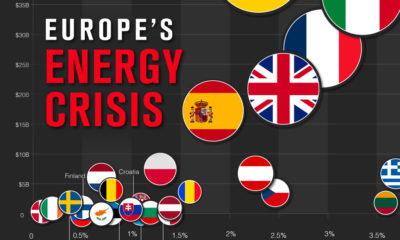No, but the actual answer is just as interesting. The generally accepted theory is that today’s oil reserves come from organic materials that existed millions of years before dinosaurs roamed the earth. About 300 million years ago, these dead organic materials such as zooplankton and algae built up on the bottom of lakes and oceans in conditions where they couldn’t decompose. The organic matter then changed into kerogen, which eventually turned into oil through heat and pressure. Today’s infographic further details how oil is formed, while also covering some of oil’s uses and history. It also mentions an alternate theory on how oil is formed, which we dive into deeper below.
Courtesy of Jones Oil
How Oil is Formed – An Alternate Theory?
While the aforementioned theory on fossilized organic material is thought to explain the vast majority of Earth’s oil reserves, there is actually another theory on how oil is formed that has been around for over a century. If it were ever proved to be true, it would be a game-changer for how we think about the world and natural resources. The theory of abiotic oil postulates that some oil on Earth originated from non-organic materials. In other words, it is made somehow by natural forces deep in the planet, or it was deposited on in the crust by meteorites. To be fair, it is true that hydrocarbons have been proven to exist in outer space, where there are no organic materials. It was also shown in 2009 that ethane and heavier hydrocarbons can be synthesized under the pressure-temperature conditions of the upper mantle. The trouble with the theory? So far, abiotic oil has not been proven to exist on Earth in any economic quantities. Oil exploration geologists have also not been able to make any discoveries using abiotic theories, and many abiotic claims have been debunked as pseudoscience. For now, this theory seems like a long shot, but it’s still interesting to think about.
on
#1: High Reliability
Nuclear power plants run 24/7 and are the most reliable source of sustainable energy. Nuclear electricity generation remains steady around the clock throughout the day, week, and year. Meanwhile, daily solar generation peaks in the afternoon when electricity demand is usually lower, and wind generation depends on wind speeds.As the use of variable solar and wind power increases globally, nuclear offers a stable and reliable backbone for a clean electricity grid.
#2: Clean Electricity
Nuclear reactors use fission to generate electricity without any greenhouse gas (GHG) emissions.Consequently, nuclear power is the cleanest energy source on a lifecycle basis, measured in CO2-equivalent emissions per gigawatt-hour (GWh) of electricity produced by a power plant over its lifetime. The lifecycle emissions from a typical nuclear power plant are 273 times lower than coal and 163 times lower than natural gas. Furthermore, nuclear is relatively less resource-intensive, allowing for lower supply chain emissions than wind and solar plants.
#3: Stable Affordability
Although nuclear plants can be expensive to build, they are cost-competitive in the long run. Most nuclear plants have an initial lifetime of around 40 years, after which they can continue operating with approved lifetime extensions. Nuclear plants with lifetime extensions are the cheapest sources of electricity in the United States, and 88 of the country’s 92 reactors have received approvals for 20-year extensions. Additionally, according to the World Nuclear Association, nuclear plants are relatively less susceptible to fuel price volatility than natural gas plants, allowing for stable costs of electricity generation.
#4: Energy Efficiency
Nuclear’s high energy return on investment (EROI) exemplifies its exceptional efficiency. EROI measures how many units of energy are returned for every unit invested in building and running a power plant, over its lifetime. According to a 2018 study by Weissbach et al., nuclear’s EROI is 75 units, making it the most efficient energy source by some distance, with hydropower ranking second at 35 units.
#5: Sustainable Innovation
New, advanced reactor designs are bypassing many of the difficulties faced by traditional nuclear plants, making nuclear power more accessible.
Small Modular Reactors (SMRs) are much smaller than conventional reactors and are modular—meaning that their components can be transported and assembled in different locations. Microreactors are smaller than SMRs and are designed to provide electricity in remote and small market areas. They can also serve as backup power sources during emergencies.
These reactor designs offer several advantages, including lower initial capital costs, portability, and increased scalability.
A Nuclear-Powered Future
Nuclear power is making a remarkable comeback as countries work to achieve climate goals and ultimately, a state of energy utopia. Besides the 423 reactors in operation worldwide, another 56 reactors are under construction, and at least 69 more are planned for construction. Some nations, like Japan, have also reversed their attitudes toward nuclear power, embracing it as a clean and reliable energy source for the future. CanAlaska is a leading exploration company in the Athabasca Basin, the Earth’s richest uranium depository. Click here to learn more now. In part 3 of the Road to Energy Utopia series, we explore the unique properties of uranium, the fuel that powers nuclear reactors.






























